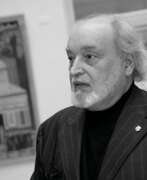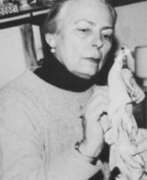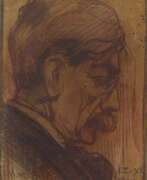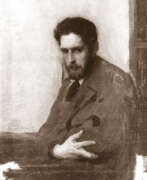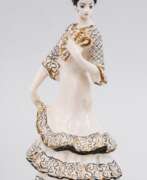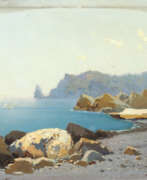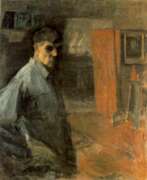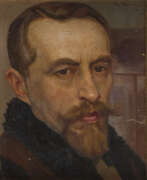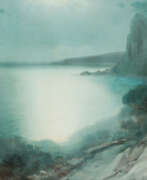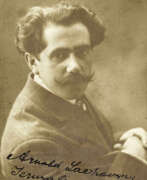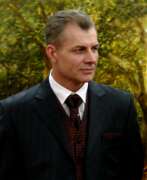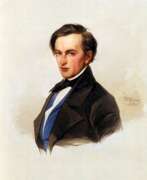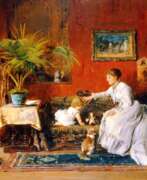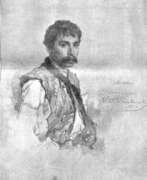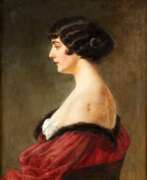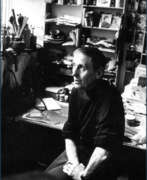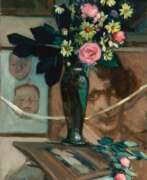Ukraine Realism


Vsevolod Grigorievich Averin (Russian: Всеволод Григорьевич Аверин) was a Ukrainian Soviet graphic artist and book illustrator. He was one of the most important Ukrainian animal painters of the first half of the 20th century, incorporating avant-garde techniques into his work.
Averin worked in book and easel graphics, especially lithography, as well as portrait and landscape painting. He illustrated many well-known works, including the Atlas of Human Anatomy and a novel by M. Twain. His work was characterised by an exquisite style and harmonious design, and his estate includes some 300 bindings, 3,000 illustrations and 90 posters.


Maria Konstantinovna Bashkirtseva (Russian: Мария Константиновна Башки́рцева) was a Russian artist of the second half of the 19th century. She is known as a master of domestic and portrait genres. Most of Bashkirtseva's paintings are in a realistic style.
In her short 25-year life Maria Bashkirtseva managed to gain recognition - her works were regularly exhibited in the Paris salons and received awards. But the artist became widely known after her death through the publication of her diaries. The famous "Diary" by Bashkirtseva immediately became a European bestseller. At the beginning of the XXI century on the basis of the original manuscripts of the author found in the National Library of France the complete 16-volume version of the diary was issued.
Much of the artist's work was lost during World War II. The few surviving masterpieces are now kept in museums in Ukraine, Russia, France and the USA.


Victoria Markovna Belakovskaya (Russian: Виктория Марковна Белаковская) was a Russian Soviet artist of the mid-twentieth century. She is known as a painter, graphic artist and representative of the Leningrad school of painting.
Victoria Belakovskaya participated in exhibitions of Leningrad artists since the early 1930s. Her work covers various genres, including portraits, genre compositions, still lifes and landscapes. Her famous works include "Pioneer Girl" (1931), "Self-Portrait with a Cigarette" (1936), "Leningrad Landscape" (1953), "Spring Flowers. Still Life" (1961), a series of landscapes of Altai, Crimea, Kiev and others.
Works by the artist are in the collections of museums in Russia, Great Britain, USA, France and other countries.
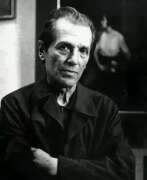

Piotr Petrovich Belousov (Russian: Пётр Петро́вич Белоу́сов) was a distinguished Soviet and Russian artist, born on May 3, 1912, in Berdyansk, and passed away on March 31, 1989, in Leningrad. He is widely celebrated for his contributions to the Leningrad School of Painting, having been an influential figure in shaping the artistic landscape of the region. His expertise extended across various mediums, including painting, etching, and graphic arts, with a notable focus on themes like the Bolshevik Revolution and historical Soviet figures like Lenin.
Belousov's educational and professional journey was deeply intertwined with the prestigious Ilya Repin Leningrad Institute of Painting, Sculpture and Architecture, where he both studied and later taught, eventually rising to the rank of professor and head of the drawing department by 1956. His career was marked by numerous accolades, including the titles of Honored Artist and People's Artist of the RSFSR, reflecting his significant impact on Russian art and education.
Throughout his life, Belousov participated in many exhibitions and his works are held in high esteem, not only in Russian state museums like the Russian Museum and the Tretyakov Gallery but also internationally. His pieces, particularly those that capture key moments in Soviet history and urban landscapes, remain influential and are sought after by collectors around the worl.
For enthusiasts of Soviet art and collectors interested in Belousov's works, staying updated on exhibitions and sales can provide valuable opportunities to acquire his art. To receive alerts about new product sales and auction events featuring Piotr Petrovich Belousov's works, signing up for updates is highly recommended.
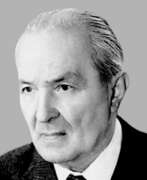

Vilmos-József Istvanovich Berets (Russian: Вильмош-Йожеф Иштванович Берец) was a Ukrainian Soviet artist of the second half of the twentieth century of Hungarian origin. He is known as a painter, graphic artist, teacher, and art historian.
Berets created works mainly in easel graphics, among his most outstanding works are watercolor landscapes. Since 1950 he actively participated in art exhibitions. He was also the author of articles on the theory of art, as well as studies on various artists, including the work of Transcarpathian artists, in the course of which the master collected extensive archival material on the history of the local school of painting.
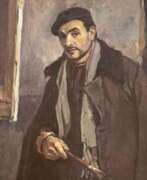

Alexander Alexandrovich Blinkov (Russian: Александр Александрович Блинков) was a Soviet and Russian artist of the twentieth century. He is known as a painter, graphic artist and teacher.
Alexander Blinkov painted genre and battle paintings, portraits, landscapes, animalistics, and also created dioramas and panoramas. Among the famous works of the artist are the paintings "The Taking of Vyborg by Soviet troops", "Partisan Trails", "Kursk Bulge", "Naval Maneuvers", panorama "Defense of Petrograd", diorama "Battle of Stalingrad" and others.
Blinkov actively taught and was associated with the Higher Art and Industrial School in Leningrad. His works are in museums and private collections in Russia, Japan, France, Ukraine, Germany and other countries.


Nikolai Kornilievich Bodarevsky (Russian: Николай Корнилиевич Бодаревский) was a Russian and Ukrainian artist of the last third of the 19th and early 20th centuries of Moldavian origin. He is known as a painter and graphic artist.
Nikolai Bodarevsky created portraits, landscapes and genre paintings. During the early period of his creativity, he was close to the Itinerants, in later years he departed from the Itinerant traditions in the direction of the late "salon" academism. His works are in many museum collections, including the State Tretyakov Gallery in Moscow and the State Russian Museum in St. Petersburg.


József Boksay (Russian: Иосиф Иосифович Бокшай) was a prominent Hungarian landscape painter and graphic artist, born on October 2, 1891, in Gyertyánliget and passing away on October 19, 1975, in Ungvár. His work significantly contributed to the artistic life of Carpathian Ruthenia, making him a notable figure in the Carpathian school of painting. Graduating from the Hungarian Academy of Fine Arts in 1914, where Imre Révész was his master, Boksay embarked on a journey of teaching and creating. His post-graduation life saw him taking study trips across European cities such as Vienna, Paris, and Budapest, further enriching his artistic vision.
Boksay's dedication to the arts led him to co-found a free school with Béla Erdélyi in 1927, aiming to nurture the region's artistic talent. His academic contributions continued post-World War II, teaching at the Fine Arts College in Ungvár and the Industrial Art School in Lemberg (now Lviv). A significant portion of his works delves into religious themes, a testament to his deep engagement with ecclesiastical art. This involvement is vividly illustrated by his transformative work on the ceiling frescoes of the Máriapócs church, where he meticulously integrated baroque elements with his distinctive style.
His legacy is preserved not only in his contributions to Carpathian Ruthenia's art scene but also in the numerous awards he received for his work. Today, his creations can be found in the museums of Carpathian Ruthenia and the Tretyakov Gallery, showcasing his lasting influence on the region's cultural heritage.
For collectors and art enthusiasts interested in the unique blend of cultural and artistic expressions that define Carpathian Ruthenia, Boksay's work offers a captivating exploration. His contributions to ecclesiastical and landscape painting underscore the rich tapestry of this region's art history. Sign up for updates to stay informed about new product sales and auction events related to József Boksay, ensuring you never miss an opportunity to engage with the legacy of this distinguished artist.
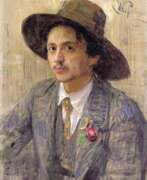

Isaak Israelievich Brodsky (Russian: Исаак Израилевич Бродский), a distinguished Russian artist, was renowned for his contributions to painting and teaching. Born in Sofievka, Russian Empire, Brodsky's artistic journey led him to become a pivotal figure in the Soviet art scene, primarily recognized for his realistic portraits and social realist works. His dedication to capturing the essence of his subjects, combined with a unique sensitivity to color and form, allowed his art to transcend mere representation, offering insights into the culture and political climate of his time.
Throughout his career, Brodsky was closely associated with significant cultural and political developments in Soviet Russia, becoming an official artist of the Soviet regime. His works, such as the iconic portraits of Lenin and other political figures, not only exemplify his skill but also serve as historical documents, offering a glimpse into the era's social fabric. His commitment to realism and the portrayal of Soviet ideals earned him a prominent place in the art world, influencing generations of artists through his role as a teacher and mentor at the Repin Institute of Arts.
Brodsky's legacy is preserved in numerous museums and galleries, with his masterpieces forming an integral part of Russia's cultural heritage. His ability to intertwine art with historical narrative has made his work a subject of study for art collectors and experts alike. For those intrigued by the depth and historical significance of Soviet art, Brodsky's oeuvre offers a fascinating exploration into the power of visual storytelling.
For collectors and experts keen on delving deeper into the rich tapestry of Russian art, staying informed about Isaac Israelievich Brodsky's work is essential. Signing up for updates ensures exclusive access to news on product sales and auction events dedicated to Brodsky's art, providing a unique opportunity to engage with the history and culture he so vividly depicted. Join us in celebrating the legacy of a true maestro of painting, whose works continue to inspire and captivate audiences worldwide.


Nikolai Evlampievich Bublikov (Russian: Николай Евлампиевич Бубликов) was a Russian and Soviet artist of the late 19th and first half of the 20th centuries. He is known as a marine and landscape painter, a representative of the Leningrad school of painting.
Nikolai Bublikov was distinguished by the use of a wide spatial perspective and a subtle range of colors in his works. He is considered the first artist who in his work raised the theme of the Soviet Navy. During the Great Patriotic War, the artist stayed in Leningrad and died during the siege of the city.
His works can be found in various museums and private collections in Russia and abroad, including the Russian Museum and the Central Naval Museum in St. Petersburg.
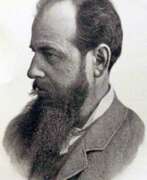

Joseph-Casimir Konstantinovich Budkevich (Russian: Иосиф-Казимир Константинович Будкевич) was a Ukrainian painter and draftsman, born on April 18, 1841, in Kyiv. Known for his battle scenes and landscapes, Budkevich studied at the Imperial Academy of Arts in Saint Petersburg, where he received several medals for his works. In 1873, he was awarded the title of Class Artist 3rd Degree.
Budkevich traveled to Italy, France, Spain, and Palestine to refine his skills. In the late 1870s and 1880s, he taught at the Kyiv Drawing School, where one of his students was Mykola Pymonenko. From 1887 to 1895, he was a member of the Kyiv Society of Art Exhibitions.
Among his notable works are "Pilgrim at the Monastery Wall" (1883) and "Jerusalem" (1894). These paintings are exhibited at the Kyiv Museum of Russian Art and the Pskov Art Gallery. His work is highly valued by collectors and art experts for its uniqueness and mastery.
If you want to receive notifications about new arrivals and auctions related to Joseph-Casimir Budkevich's work, subscribe to our updates. We will keep you informed about new sales and events related to his legacy.
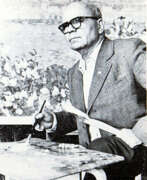

Vasily Dmitrievich Chegodar (Russian: Василий Дмитриевич Чегодар) was a Soviet and Ukrainian artist of the second half of the twentieth century. He is known as a painter who worked in the genres of landscape and still life.
Vasily Chegodar gained recognition by starting to participate in art exhibitions since 1942. An important period in his work was the 1950s, when he fully devoted himself to painting and became known for his Kiev landscapes. The artist left a rich creative legacy, including about ten thousand paintings and graphic works, some of which are in private collections in Ukraine, Russia and Europe.
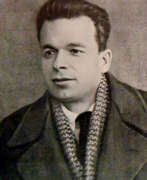

Ivan Ivanovich Cherinko (Rusian: Иван Иванович Черинько) was a Soviet Ukrainian artist who moved to Turkmenistan, after visiting Ashgabat in 1933 and finding the city beautiful and picturesque. He was among the Russian-trained artists who came to Turkmenistan and created works of art the captured the nature and culture of the republic. He founded the Union of Artists of Turkmenistan in the 1930s and co-founded the Sh. Rustaveli Turkmen Art School. In 1945, he was named an Honored Art Worker of the Turkmen Soviet Socialist Republic (Turkmen SSR, 1925–1991).
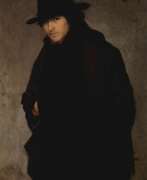

Philipp Antonovich Chirko (Russian: Филипп Антонович Чирко) was a Russian and Ukrainian painter, born on July 3, 1859, in Kyiv. Chirko was known for his realistic style and was associated with the Peredvizhniki movement, a group of artists committed to social realism and traveling exhibitions. He studied at the Kyiv Drawing School and later at the Imperial Academy of Arts in Saint Petersburg, graduating in 1892.
Chirko’s works often depicted battle scenes, genre paintings, and landscapes of Ukraine. Notable paintings include "The Pursuit of French Mounted Chasseurs by the Horse Guards under Polotsk on August 6, 1812," which is part of the Borodino Panorama Museum's collection in Moscow. Unfortunately, many of his works were lost during World War II.
Chirko’s remaining works are highly valued by collectors and can be found in various Russian museums, including the Chernihiv Art Museum. His contribution to art is significant for its historical and artistic value, capturing the essence of his era.
Sign up for updates related to Philipp Antonovich Chirko to receive notifications about new product sales and auction events.
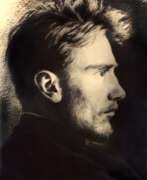

Grigory Kononovich Dyadchenko (Russian: Григорий Кононович Дядченко) was a Ukrainian artist and educator, born on October 8, 1869, in Kirilovka. Known for his landscape and portrait paintings, Dyadchenko's work embodies the realism movement. He studied at the Kyiv Drawing School and later graduated from the Imperial Academy of Arts in St. Petersburg, where he earned multiple awards.
Dyadchenko's artistry is evident in his poetic landscapes such as "Evening on the Dnieper" and "Kiev. View of Podil," which are characterized by their atmospheric depth and emotional resonance. His portraits, including "Head of a Girl" and the depiction of sculptor F. Balavensky, are celebrated for their psychological insight.
Dyadchenko also contributed to art education by teaching at the Kyiv Drawing School, influencing future artists like Mykhailo Kozyk and Vasyl Sylvestrov. His works are preserved in the National Art Museum of Ukraine and other prominent collections.
For those interested in Dyadchenko's art, sign up for updates on new product sales and auction events related to his masterpieces.
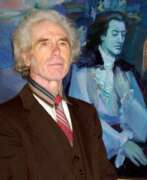

Stefan Ivanovich Florescu (Russian: Степан Иванович Флореску) was a Soviet and Moldovan artist of the second half of the twentieth and early twenty-first centuries. He is known as a painter, graphic artist and inventor who solved complex artistic problems using the methodology of the theory of inventive problem solving.
Starting in art at a young age, Stefan Florescu sought to develop not only his knowledge but also his skills as a portrait painter, exploring the complex aspects of human nature. His work encompassed various genres, including thematic compositions, landscapes, still lifes and portraits, as well as utilizing a variety of artistic and technical methods to create expressive images.
During his career, the master created more than 10,000 sketches, sketches, and sketches; about 250 graphic works; more than 390 pictorial compositions; and two sculptural projects.
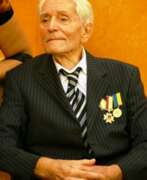

Albin Stanislavovich Gavdzinsky (Russian: Альбин Станиславович Гавдзинский) was a Soviet and Ukrainian artist of the second half of the twentieth and early twenty-first centuries. He is known as a painter, famous for his landscapes, genre paintings and portraits.
Albin Gavdzinsky in the early 1950s held his first solo exhibitions in Odessa, Kiev and Kharkov and showed his bright artistic personality. The artist was distinguished by his outstanding efficiency and precision in depiction, which was evident in his clear forms and bright colors. In 1961 he was recognized as Honorary Citizen of the city of Novaya Kakhovka, and his works (237 canvases) served as the basis for the creation of the city's art gallery, which in 2003 was named after him.
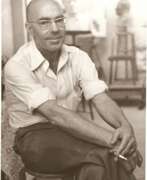

Grigory Ivanovich Gavrilenko (Russian: Григорий Иванович Гавриленко) was a Ukrainian Soviet artist of the mid-twentieth century. He is known as a graphic artist and illustrator, a representative of Ukrainian avant-garde art, a "sixties" artist.
Grigory Gavrilenko became famous for his graphic works, including landscapes and portraits. His work included a variety of techniques and styles, from quick sketches to laconic drawings-formulas. The master also designed and illustrated many books, including folk tales. In the last years of his life, he worked extensively in color linocuts, creating prints and illustrations.


Nikolai Nikolaevich Ge (Russian: Николай Николаевич Ге) was a distinguished Russian painter, whose contributions to the world of art are celebrated for their emotional depth and philosophical introspection. Born in 1831, Ge's work spans a variety of themes, including religious, historical, and psychological subjects, making him a versatile artist in the realm of 19th-century Russian culture. His paintings are known not just for their aesthetic appeal but also for their ability to provoke thought and evoke deep emotions.
Ge's art is marked by its intense exploration of moral and spiritual questions, distinguishing him from his contemporaries. One of his most famous works, "The Last Supper" (1863), showcases his ability to infuse traditional religious scenes with a new level of emotional intensity and humanism. This painting, along with others like "Christ in the Garden of Gethsemane" (1868), reflects Ge's deep engagement with the themes of suffering, redemption, and the human condition. His approach to these universal subjects has earned him a special place in the canon of Russian art, making his works highly sought after by collectors and experts in art and antiques.
Ge's contributions to art extend beyond his individual works. His commitment to portraying the human experience with honesty and depth has influenced generations of artists. His paintings can be found in prestigious galleries and museums, serving as a testament to his enduring legacy. For collectors and art aficionados, Ge's work represents not only an investment in Russian culture and history but also an ongoing exploration of the depths of human emotion and spirituality.
For those interested in the profound and moving art of Nikolai Nikolaevich Ge, staying informed about new discoveries, sales, and auction events related to his work is essential. Sign up for updates to ensure you never miss an opportunity to engage with the legacy of this remarkable artist. This subscription will exclusively alert you to new product sales and auction events related to Nikolai Nikolaevich Ge, keeping you connected to the very best of Russian art and culture.
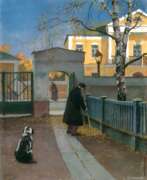

Mikhail Markianovich Germashev (Russian: Михаил Маркианович Гермашев) was a Russian painter known for his exquisite landscape paintings. Born in 1867 in Kharkov, he studied at the Moscow School of Painting, Sculpture and Architecture. Germashev's works are celebrated for their atmospheric depictions of Russian winters and serene rural scenes.
Germashev gained significant recognition in the late 19th century. His painting "Snow Fell" won first prize at the Moscow Society of Arts in 1897 and was acquired by the renowned collector Pavel Tretyakov. Other notable works include "Gray Day" (1894), "Unfrozen River" (1898), and "Rainy Day" (1902). These paintings are displayed in various museums across Russia, reflecting Germashev's prominence in the art world.
In the 1920s, Germashev moved to Paris, where he continued to paint and exhibit his works. His landscapes, characterized by their high craftsmanship and beauty, remained popular among collectors and art enthusiasts. His works can be found in prestigious collections, including the Tretyakov Gallery and the Museum of Moscow.
Stay updated on the latest sales and auction events for works by Mikhail Markianovich Germashev by subscribing to our newsletter. Don't miss the opportunity to add a piece of Russian art history to your collection!
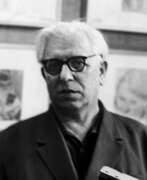

Vladimir Alexandrovich Gorb (Russian: Влади́мир Алекса́ндрович Го́рб) was a Soviet Russian artist, renowned for his versatile talents in painting, graphic design, and art education. Born on December 31, 1903, in Odessa, Russian Empire, Gorb carved a niche for himself in the Leningrad art scene, contributing extensively to its richness and diversity.
Gorb's education at the Leningrad VKHUTEIN under influential teachers like Alexander Savinov and Kuzma Petrov-Vodkin equipped him with a formidable artistic foundation, which he expanded upon throughout his career. His works, characterized by their vivid portrayal of everyday life and the natural world, were regularly featured in prominent exhibitions from as early as 1925.
Over the years, Gorb became a significant figure in the Soviet art community, not only through his artwork but also through his role as a professor at the Repin Institute of Arts. His commitment to art education shaped many future artists. His works are notable for their depth and complexity, encapsulating the Soviet ethos with a unique blend of realism and personal expression.
For those interested in exploring the works of Vladimir Gorb further or acquiring pieces for their collections, more information is available through dedicated art galleries and historical art resources online. For updates on exhibitions and available works of Vladimir Gorb, you can subscribe to our newsletter, ensuring you're informed about new sales and auction events related to this distinguished artist.
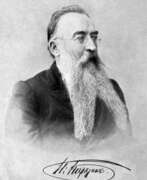

Nikolay Nikolaevich Karazin (Russian: Николай Николаевич Каразин) was a Russian military officer, painter, and writer, known for his depictions of wars and exotic places. Born in 1842 in Kharkov (now Ukraine), Karazin came from a family of prominent intellectuals, including his grandfather Vasily Karazin, who founded Kharkiv University.
Karazin's career began in the military, where he participated in campaigns against the January Uprising in Poland and in Central Asia. His firsthand experiences in battles, such as the 1868 Bukhara campaign and the 1873 Khiva campaign, greatly influenced his later work as a painter and writer. After retiring from the military, he focused on creating large canvases depicting military actions in Turkestan, as well as writing numerous adventure and ethnographic stories and novels.
Karazin's works, which include "In the Distant Confines" (1875) and "From Orenburg to Tashkent" (1886), reflect his deep engagement with the landscapes and cultures of Central Asia. His children's book "Cranes Flying South" remains popular for its vivid storytelling and illustrations. Karazin also contributed significantly to the visual arts, participating in early designs for the Moscow Metro and becoming an academician of the Imperial Academy of Arts in 1904.
To stay updated on new product sales and auction events related to Nikolay Karazin's works, sign up for our updates. This subscription will keep you informed about the latest opportunities to acquire pieces of his illustrious legacy.
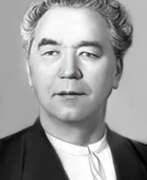

Vasyl Illich Kasiyan (Russian: Василий Ильич Касиян) Vasyl Illich Kasiyan was a Ukrainian artist and graphic designer, celebrated for his contributions to Soviet and Ukrainian visual arts. Born on January 1, 1896, in Mykulyntsi, then part of Austria-Hungary, and passing on June 26, 1976, in Kyiv, Ukrainian SSR, Kasiyan's journey through art was marked by his distinct influence on Soviet-era visual narratives. A World War I veteran, he further honed his artistic skills at the Academy of Fine Arts in Prague in the 1920s under the mentorship of Czech painter Max Švabinský.
Kasiyan's body of work spans various mediums, reflecting the ethos of his times with a deep focus on people, their struggles, and the landscapes they inhabit. Notably, his artworks such as "Portrait of a Young Woman" (1950), "Taras Shevchenko" (1945), and "My Mother" (1940) underscore his mastery in capturing the essence of his subjects, rendering them with an emotional depth that speaks volumes about his connection to the cultural and political landscape of the Soviet Union.
His contributions were widely recognized, earning him titles like the People's Artist of the Soviet Union and the Shevchenko National Prize in 1964, affirming his status as a pivotal figure in Soviet and Ukrainian art. Kasiyan's legacy is not just in the beauty of his works but also in his role as an educator and influencer in the art community, contributing significantly to the National Academy of Visual Arts and Architecture and the Kharkiv Institute of Arts.
For collectors and experts in art and antiques, Vasyl Illich Kasiyan's works represent not only aesthetic beauty but also a historical narrative of the Soviet and Ukrainian people's resilience and spirit. His pieces, found in museums and galleries worldwide, continue to inspire and provoke thought, offering a window into the artist's profound connection with his heritage.
To stay updated on exhibitions and sales featuring Vasyl Illich Kasiyan's art, sign up for our newsletter. This subscription ensures you're the first to know about new discoveries, auction events, and exclusive sales related to this esteemed artist's works.
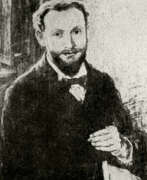

Solomon Yakovlevich Kishinevsky (Russian: Соломон Яковлевич Кишинёвский) was a Russian and Soviet artist of the late 19th and the first half of the 20th centuries of Jewish origin. He is known as a painter, graphic artist and teacher, a prominent representative of the Southern Russian school of painting.
Solomon Kishinevsky worked in domestic, portrait and landscape genres. At the beginning of his career, he was fond of German and Italian classicism, then French impressionism, but the first serious works he created under the strong influence of the Itinerants. His life sketches, scenes from the life of the urban poor were acutely social, the artist has a special attention to the everyday existence of the "little man.
Kishinevsky died presumably in 1941 during the Nazi occupation of Odessa.
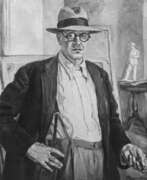

Pyotr Konchalovsky (Russian: Пётр Петрович Кончаловский) was a renowned Russian painter, a prominent member of the Jack of Diamonds group, which sought to blend modern French and German art with Russian primitivism. Born into an artistic family, Konchalovsky's career spanned several decades, during which he became known for his extensive use of color and innovative approach to composition. Influenced by Paul Cézanne, his works demonstrate a complex evolution of styles, from impressionism to socialist realism, without fully embracing abstraction. Konchalovsky's repertoire includes over five thousand works, comprising still lifes, landscapes, and portraits that contributed significantly to the development of Soviet realistic art. Notably, his artistry extended beyond his canvas; his family legacy includes notable figures in the arts, contributing to his lasting impact on both Russian and global art scenes.
His significant contribution to the avant-garde movement and his distinctive style, blending Fauvism and Cubism with realism, positioned him as a key figure in pre-Soviet and Soviet art. Despite challenges, including initial rejection in his homeland and a complex relationship with the Soviet regime, Konchalovsky's work received acclaim, including exhibitions at the prestigious Tretyakov Gallery. His legacy is preserved through the Petr Konchalovsky Foundation, ensuring his vibrant and dynamic works continue to inspire.
For collectors and experts in art and antiques, Konchalovsky's work offers a unique window into the evolution of Russian art during a turbulent century. His ability to synthesize various artistic influences while maintaining a distinctive voice makes his work a valuable addition to any collection.
To stay updated on sales and auction events related to Pyotr Konchalovsky's art, sign up for our newsletter. This subscription ensures you're informed about new opportunities to acquire pieces by this remarkable artist.


Olga Yurievna Kotlyarova-Prokopenko (Russian: Ольга Юрьевна Котлярова-Прокопенко) is a Soviet and contemporary Ukrainian artist. She is known as a painter and public figure, Honored Artist of Ukraine and member of the National Union of Artists.
Olga Kotlyarova-Prokopenko works in oil painting and watercolor techniques with a focus on landscapes, still lifes and portraits. Since beginning her career in 1977, she has participated in over 600 exhibitions, including 63 solo exhibitions. Her works are in many galleries in Ukraine and abroad, as well as in private collections in many countries, including France, Germany, USA and Spain. The artist holds a vice-presidential position in the Union of Marinists of Odessa and was awarded the Order of Princess Olga III degree.
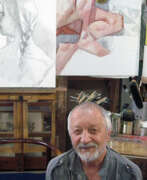

Vitaly Nikolayevich Kulikov (Russian: Виталий Николаевич Куликов) was a Soviet and Ukrainian artist of the last third of the twentieth and early twenty-first centuries. He is known as a painter, graphic artist, book designer, poster artist, as well as a teacher, who brought up several generations of artists and architects over 40 years of teaching.
Vitaly Kulikov worked in various genres, including portraiture, landscape and still life, as well as successfully engaged in graphics and design. He, according to critics, refracted the traditions of avant-garde art of the early 20th century, combining them with a philosophical outlook and sharp plastic execution.
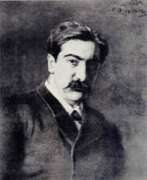

Nikolai Dmitriyevich Kuznetsov (Russian: Николай Дмитриевич Кузнецов) was a Ukrainian artist, celebrated for his profound skill in portraiture and genre scenes. Born on December 2, 1850, in the Kherson Governorate of the Russian Empire, he rose to prominence as an art professor at the St. Petersburg Imperial Academy of Arts. His works, notably his portraits, are known for their depth and psychological insight, capturing the essence of his subjects with remarkable clarity.
Kuznetsov's portfolio includes influential Russian figures such as the composer Pyotr Ilyich Tchaikovsky, whose portrait by Kuznetsov is praised for capturing the composer's introspective tragedy. This piece remains a highlight at the Tretyakov Gallery, illustrating Kuznetsov’s ability to translate the inner life of his subjects onto canvas.
Throughout his career, Kuznetsov was involved with the Peredvizhniki, a group of artists who eschewed the formal constraints of academic art to focus on realistic portrayals of everyday life. He became an academician in 1900 and continued to influence the Russian art scene until his emigration to Yugoslavia following the upheaval of the Russian Civil War. He passed away on March 2, 1929, in Sarajevo.
For those interested in exploring Nikolai Dmitriyevich Kuznetsov’s life and works further, updates and details about upcoming sales and exhibitions can be found by subscribing here. Stay informed about the availability of his renowned artworks and ensure you don't miss out on acquiring a piece of art history.
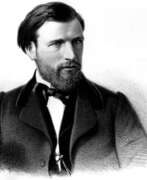

Lev Feliksovich Lagorio (Russian: Лев Феликсович Лагорио) was a Russian painter known for his exquisite seascapes and coastal landscapes. Born in 1827 in Feodosia, Crimea, Lagorio's Italian heritage and Russian upbringing greatly influenced his artistic style.
Lagorio's paintings are celebrated for their vibrant use of color and meticulous attention to detail, capturing the dynamic beauty of the sea and coastal environments. His works often depict serene seascapes, bustling ports, and dramatic coastal scenes, showcasing his ability to convey both tranquility and movement in nature. His technique involved capturing the subtle interplay of light and shadow, giving his paintings a lifelike quality.
Some of Lagorio's notable works include "View of the Caucasus Mountains from the Sea" and "Storm on the Black Sea," which are housed in prestigious institutions such as the State Russian Museum in St. Petersburg. Collectors and art enthusiasts highly value his contributions to maritime art.
For those interested in exploring the works of Lev Feliksovich Lagorio, signing up for updates on upcoming auctions and sales can provide exclusive access to new opportunities. Stay informed about the latest offerings by subscribing to our newsletter focused on Lagorio's masterpieces.
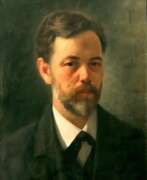

Andronik Grigorievich Lazarchuk (Russian: Андроник Григорьевич Лазарчук) was a Ukrainian and Soviet artist, born on January 15, 1870, in Ukhovetsk, Volhynian Governorate, and passed away on September 6, 1934, in Borzna, Chernihiv region. Known for his contributions to painting, teaching, and cultural activities, Lazarchuk's work primarily featured portraits, everyday scenes, and landscapes.
Lazarchuk began his artistic journey studying icon painting in Kovel and later in the Pochaev Lavra's painting workshop. From 1889 to 1897, he attended the Higher Art School at the Imperial Academy of Arts in St. Petersburg, where he studied under prominent artist Vladimir Makovsky. His artistic style was influenced by his early religious training, which is evident in his detailed and expressive portraits and landscapes.
One of his notable works, "Portrait of a Man," showcases his ability to capture human emotion and character. His other works include small-format paintings like "Reading a Letter" and "Family Group," which highlight his focus on everyday life and personal interactions. Lazarchuk also contributed to the decoration of Ukrainian churches, such as the Holy Trinity Church and the Cave Churches of Pochaev Lavra, and worked as an illustrator for magazines like "Native Land" and "Young Ukraine".
Collectors and art enthusiasts can explore Lazarchuk's legacy by signing up for updates on new product sales and auction events related to his works. This subscription will keep you informed about opportunities to acquire pieces by this influential artist.


Gavriil Kondratyevich Malysh (Russian: Гавриил Кондратьевич Малыш) was a Soviet and Russian artist of the second half of the twentieth century. He is known as a painter and watercolorist, a representative of the Leningrad school.
Gavriil Malysh worked mainly in the genres of landscape, still life and genre compositions. He became famous as a bright watercolorist, a master of lyrical landscape and decorative still life. His works are distinguished by a color palette dominated by blue, lilac and violet tonalities. His works are in numerous museums and private collections in Russia and other countries, including France, USA, Japan and Italy.
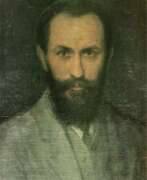

Anton Ivanovich Manastyrsky (Russian: Антон Иванович Манастырский) was a Ukrainian and Soviet artist of the twentieth century. He is known as a painter and graphic artist.
Anton Manastyrsky became famous for his genre paintings based on Ukrainian folk songs. His works are characterized by plasticity, rhythm and poetry. He also worked in the portrait genre, creating such canvases as "Portrait of Mother", "Portrait of Taras Shevchenko" and others. The master also illustrated books and worked in the religious genre, restoring the iconostasis in the Church of the Assumption of the Blessed Virgin Mary in Ancient Galich.
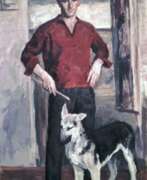

Leonid Yakovlevich Mezheritski (Russian: Леонид Яковлевич Межерицкий) was a Soviet, Ukrainian and Israeli artist of the second half of the twentieth and early twenty-first centuries. He is known as a painter who specialized in oil painting, a representative of the South Russian (Odessa) school.
Leonid Mezheritski created mainly plein air landscapes, and also worked in the genres of portraiture and still life. His style was based on the coloristic systems of French Impressionism and Post-Impressionism. His works can be found in state art museums in Ukraine and private collections in various countries, including the United States, Canada, Germany, England, Israel and Russia.
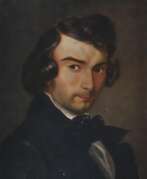

Apollon Nikolaevich Mokritsky (Russian: Аполлон Николаевич Мокрицкий) was a Ukrainian-Russian painter and art educator, known for his contributions to the 19th-century art scene. Born in 1810 in Pyryatyn, Ukraine, Mokritsky became an influential figure in Russian academic art, specializing in portrait and historical painting.
Mokritsky's work is celebrated for its detailed realism and emotional depth. His portraits often capture the essence of his subjects, showcasing his skill in rendering lifelike expressions and intricate details. One of his most notable works is the portrait of the renowned Russian poet, Taras Shevchenko, which exemplifies his ability to combine technical precision with profound sensitivity.
In addition to his painting, Mokritsky played a significant role as an educator. He taught at the Moscow School of Painting, Sculpture and Architecture, where he mentored many young artists who would go on to shape Russian art. His influence extended beyond his own works, helping to cultivate a new generation of artists.
Today, Mokritsky's paintings can be found in various museums and galleries, including the Tretyakov Gallery in Moscow. His contributions to art and education continue to be recognized and celebrated by art collectors and historians alike.
Sign up for updates to learn more about new product sales and auction events related to Apollon Nikolaevich Mokritsky.
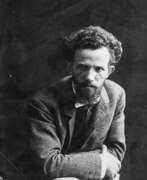

Oleksandr A. Murashko (Russian: Александр Александрович Мурашко) was a prominent artist of Russian and Ukrainian descent, renowned for his profound contributions to painting and art education. Born on August 26, 1875 in Kiev, Murashko's journey in art began at the prestigious St. Petersburg Academy of Arts, after which he honed his skills in Europe, including Paris and Munich. His determination led to the founding of the Kiev Art Academy, a milestone in the history of Ukrainian culture.
Murashko's art is characterized by a vivid depiction of light and shadow, a technique he honed during his acquaintance with Impressionism in Paris. His preference to paint intimate acquaintances rather than commissioned portraits added an individuality that resonated deeply with the art community. Despite his tragic death in 1919, Murashko's legacy lives on, notably through a special room in the National Art Museum of Ukraine and a monument on a Ukrainian bank coin in 2015, highlighting his cultural significance.
Characterized by a unique blend of realism and impressionism, his work reflected his deep connection to his roots and keen observation of light and life. The tragic end of his life, victimized by political upheaval, cut short a promising career, but his influence on Ukrainian art remains indelible.
For collectors and experts in art and antiques, Oleksandr A. Murashko's works represent not only aesthetic beauty, but also a rich historical narrative. His paintings are a testament to the resilience and creativity of an artist who has overcome the complexities of cultural identity through his art. To keep abreast of new sales and auction events featuring Murashko's work, we invite you to subscribe for updates. With this subscription, you will always be aware of all events related to this outstanding artist and will celebrate his enduring legacy in the art world.
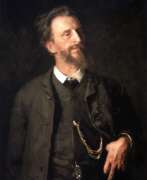

Grigori Grigorievich Myasoyedov (Russian: Григо́рий Григо́рьевич Мясое́дов) was a Russian artist of the second half of the nineteenth and early twentieth centuries. He is known as a bright representative of Russian realism and a founder of the Itinerant movement. In different years Myasoyedov turned to historical and everyday life genres, wrote portraits and landscapes. This versatile painter paid attention to religious subjects, his paintings depicted rituals, folk beliefs and customs.
Grigori Myasoyedov devoted the bulk of his career to depicting the life of the peasantry. Traveling and studying the works of Italian, German, Spanish and French artists, sculptors and architects, he was fascinated by critical realism, which flourished in Europe in the second half of the 19th century.
Determined to bring art closer to the average citizen, on his return to his homeland he founded the Association of Traveling Art Exhibitions and headed it. As one of the main participants of this movement, he himself traveled around the country with traveling exhibitions. Leaving the partnership after a conflict with the Impressionists, Myasoyedov concentrated on creativity. He created landscapes, tried his hand at graphics, and worked on theatrical sets.
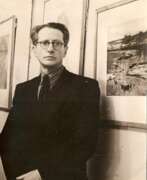

Samuil Grigorievich Nevelshtein (Russian: Самуил Григорьевич Невельштейн) was a distinguished Soviet Russian painter, watercolorist, graphic artist, and art teacher, known for his impactful role in the Leningrad school of painting. Born on March 22, 1903, in Kherson, Ukraine, then part of the Russian Empire, Nevelshtein made a significant mark in the art world with his expressive portraits and scenes reflecting Soviet life.
Nevelshtein's journey in the arts began at VKhuTeMas, a renowned Moscow art school, where he honed his skills before moving to Leningrad. There, he graduated from the Proletarian Institute of Fine Arts and became a pivotal member of the Leningrad Union of Artists from 1935. His artwork primarily includes portraits, genre compositions, and landscapes, showcasing his mastery in both watercolors and oil painting.
His works are held in high esteem and are part of collections in major museums and private collections across the globe, including the State Russian Museum. Nevelshtein's exhibitions were well-received, contributing significantly to the cultural tapestry of Leningrad, now Saint Petersburg, until his death on November 16, 1983.
For those interested in exploring the works of Samuil Nevelshtein or learning about upcoming auctions and exhibitions featuring his art, consider subscribing for updates. This will ensure you are informed about new sales and auction events related to Nevelshtein's works, enhancing your collection and knowledge of this influential artist.
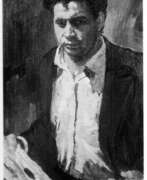

Nikolai Vasilievich Ovechkin (Russian: Николай Васильевич Овечкин) was a distinguished Soviet and Russian painter, renowned for his contributions to war art and pedagogy. Born on May 4, 1929, in Novoshakhtinsk, North Caucasus Territory, Ovechkin embarked on his artistic journey at Moscow's Central School of Industrial Art in 1945, later attending the secondary art school at the V. I. Surikov Institute, and ultimately graduating from the Moscow State Art Institute V. I. Surikov in 1961. His dedication to art education was evident through his work at Gymnasium No. 10 in Novocherkassk, where he taught drawing, and his leadership of the city's art studio established in the 1920s by M. B. Grekov.
Ovechkin's notable achievements include receiving the M. B. Grekov gold medal in 1968 for his participation in the reconstruction of F. A. Rubo's "Battle of Borodino" panorama and the USSR Academy of Arts' gold medal in 1976 for his diorama "The Battle of the Dnepr". His monumental works, such as the dioramas "The Battle of Moscow" and "The Battle of Stalingrad," showcased at the Kiev State Museum of the Great Patriotic War, highlight his mastery in capturing historical moments.
Throughout his career, Ovechkin was celebrated with numerous titles and awards, including the People's Artist of the USSR in 1985, showcasing his significant influence in Soviet and Russian art. His artworks, deeply rooted in historical and patriotic themes, continue to be valued by collectors and art enthusiasts.
For those intrigued by Nikolai Vasilievich Ovechkin's art and wish to explore more about his legacy or add a piece of his work to their collection, stay informed about new sales and auction events. Signing up for updates will ensure you don't miss out on the opportunity to own a part of this esteemed artist's history.
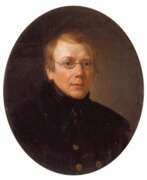

Kapiton Stepanovich Pavlov (Russian: Капитон Степанович Павлов) was a Russian and Ukrainian artist of the first half of the 19th century. He is known as a painter, landscape painter, portraitist, author of genre compositions and teacher.
Kapiton Pavlov was one of the first painters in Ukraine, who depicted in his paintings real scenes from the lives of ordinary people. His portraits are characterized by poetization of the human environment. A special place in his work were children's portraits, which, according to critics, reflected the sentimental and poetic temperament of the Ukrainian soul.


Konstantin Konstantinovich Pervukhin (Russian: Константи́н Константи́нович Перву́хин) was a Russian artist of Ukrainian origin of the late 19th and early 20th centuries. He is known as an impressionist landscape painter, illustrator, and photographer.
Konstantin Pervukhin is considered one of the greatest Russian artists of the turn of the century, continuing the traditions of the Russian landscape school. His work reflected many of the trends characteristic of the art of the time. At the height of his career, the artist used many impressionistic techniques in painting: he painted in a free manner, paying particular attention to the transfer of light and air environment and the changing states of nature.
Pervukhin was a Wanderer and one of the founders of the Union of Russian Artists.
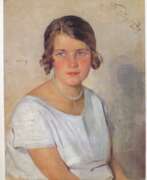

Mikhail Rodionovich Pestrikov (Russian: Михаил Родионович Пестриков) was a Russian and Soviet artist of the late 19th and the first third of the 20th centuries. He is known as a painter and teacher.
Mikhail Pestrikov was engaged in easel and monumental and decorative painting. He wrote portraits, created a number of paintings of biblical themes. The artist also carried out murals in houses, scientific institutions and churches.
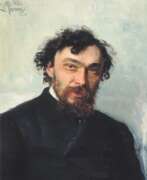

Ivan Pavlovich Pokhitonov (Russian: Иван Павлович Похитонов) was a Russian artist of the late 19th and early 20th centuries. He is known as a painter and graphic artist, a master of landscape, who lived and worked in Europe for much of his career.
Ivan Pokhitonov created mainly miniature landscapes, made with a small brush on planks of red or lemon wood, treated and primed with a special technology. He worked mostly in plein air. The most common motif of his miniature paintings during the years of emigration were city and seascapes of France. In his works, always built on a combination of the finest shades of color, the artist organically combined the techniques of Barbizon, of which he was a fan, and the traditions of the Russian landscape school. He also turned to the genre of still life and portraiture.
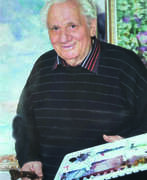

Vasily Andreyevich Ponikarov (Russian: Василий Андреевич Поникаров) was a Soviet and Ukrainian artist of the second half of the twentieth and early twenty-first centuries. He is known as a painter, graphic artist and watercolorist, master of landscape and still life.
Vasily Ponikarov used the technique of "wet" watercolor, applying paints on pre-moistened paper, which gave his works a special softness. The artist worked exclusively with watercolor, not using other techniques. His landscapes often depicted Odessa and its surroundings, and still lifes were distinguished by bright colors and depiction of abundant natural gifts of the south of Ukraine. The master's individual style brought him wide recognition and success.
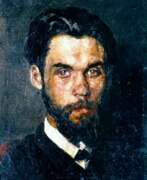

Mykola Kornylovych Pimonenko (Russian: Николай Корнильевич Пимоненко) was a Ukrainian artist who became famous for his significant contribution to world painting. Born in the heart of Ukraine, the artist was deeply imbued with the rich tapestry of Ukrainian culture, which allowed him to convey the essence of rural life with profound realism and emotional depth. His specialization in genre painting and portraiture allowed him to depict the everyday life of his compatriots, which earned him a place of honor among the luminaries of Ukrainian art.
Pimonenko's works are distinguished by their meticulous attention to detail, bright color palette and ability to convey the simple beauty of Ukraine's landscapes and its people. His paintings often depict scenes from peasant life, holidays, and folk traditions, indicating his deep connection to his heritage and his desire to preserve Ukraine's cultural identity through his art.
His masterpieces have found a place in prestigious galleries and museums both in Ukraine and abroad, testifying to his enduring legacy. The National Art Museum of Ukraine and the Tretyakov Gallery in Moscow are among the institutions that house Pimonenko's works, allowing art lovers and collectors to marvel at his contribution to the art world.
For collectors and experts in art and antiques, Timonenko's work represents not only aesthetic beauty, but also a cultural and historical richness that is unparalleled. His ability to weave narrative, emotion and cultural identity into his paintings makes them invaluable to those who appreciate the intricacies of art and history.
If you are an art and antiques collector or expert and would like to keep up to date with new discoveries, sales and auction events related to Nikolai Pimonenko, we invite you to subscribe to updates. This subscription is a customized service designed to keep you up-to-date on the latest happenings in the art world, focusing exclusively on works related to this esteemed artist. Join our community so that you don't miss the opportunity to add a piece of Ukrainian cultural heritage to your collection.


Ilya Yefimovich Repin (Russian: Илья Ефимович Репин) was a preeminent Russian artist, celebrated for his profound influence on the world of art, particularly painting. Born in 1844 in the Russian Empire, Repin distinguished himself as a pivotal figure in bringing Russian art to the forefront of the European scene. His works, characterized by their vivid realism and profound emotional depth, offer a window into the cultural, social, and historical landscapes of 19th-century Russia.
Repin's oeuvre is a testament to his exceptional skill in capturing the essence of his subjects, ranging from the peasantry to the elite, and his commitment to portraying the Russian spirit. His paintings, such as "Barge Haulers on the Volga" and "Ivan the Terrible and His Son Ivan," are lauded for their meticulous detail, dynamic compositions, and the way they convey powerful narratives and emotions. These masterpieces are housed in prestigious museums and galleries worldwide, including the State Russian Museum and the Tretyakov Gallery, affirming Repin's enduring legacy in the annals of art history.
For collectors and experts in art and antiques, Repin's works represent not only significant cultural and historical value but also a deep emotional resonance that transcends time. His ability to intertwine the beauty and tragedy of human experience with the rich tapestry of Russian culture makes his art a compelling exploration for enthusiasts and scholars alike. To stay informed about new product sales and auction events related to Ilya Yefimovich Repin, we invite you to sign up for updates. This subscription is a gateway to exclusive insights and opportunities in the realm of art and antiques, focusing solely on Repin's illustrious work.
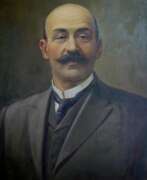

Franz Roubaud (Russian: Франц Алексеевич Рубо) was a Russian painter, known for his panoramic paintings and battle scenes. Born in Odessa in 1856, Roubaud studied at the Imperial Academy of Arts in St. Petersburg and furthered his education in Munich. His works are celebrated for their meticulous detail and dynamic composition.
One of his most famous works is the "Siege of Sevastopol," a monumental panorama depicting a key event from the Crimean War. This masterpiece is housed in the Panorama Museum in Sevastopol and stands as a testament to Roubaud's ability to convey historical grandeur and emotional intensity.
Roubaud's contributions to Russian art extend beyond his canvases, as he was also a respected professor at the Academy of Arts in St. Petersburg. His legacy continues to influence modern Russian painters, and his works are sought after by collectors and art enthusiasts worldwide.
Stay updated on new product sales and auction events related to Franz Roubaud (Rubo) by signing up for our newsletter. Don’t miss the chance to own a piece of history!
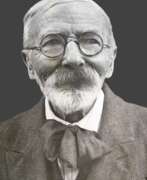

Nikolay Semyonovich Samokish (Russian: Николай Семёнович Самокиш) was a distinguished Russian artist and painter, renowned for his contributions to the realms of military, historical, and animal genre painting. Born in the late 19th century, Samokish's work encapsulates the vibrant culture and art of his time, showcasing his exceptional skills in sculpture and painting that have captivated art collectors and experts alike.
Samokish's oeuvre is celebrated for its meticulous attention to detail, dynamic compositions, and the ability to evoke emotion and narrative through visual art. His paintings often depict scenes of historical significance or moments of everyday life, rendered with a realism and intensity that bring the subjects to life. Among his known works, many are housed in prestigious museums and galleries, serving as testament to his enduring legacy in the art world.
For collectors and aficionados of art and antiques, Samokish's work represents a unique intersection of culture, history, and artistic excellence. His pieces are not only valuable for their aesthetic appeal but also for their historical context, making them sought-after additions to any collection. To stay informed about new product sales and auction events featuring Nikolay Semyonovich Samokish's work, we invite you to sign up for updates. This subscription is your gateway to exploring the exquisite artistry of Samokish, ensuring you don't miss an opportunity to own a piece of cultural heritage.
This exploration into Nikolay Semyonovich Samokish's life and work is based on a thorough review of available information, aiming to provide a concise yet comprehensive overview that resonates with art collectors and experts. His contributions to the field of art continue to inspire and attract admiration, underscoring the timeless appeal of his work.
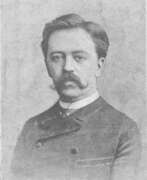

Ivan Fyodorovich Seleznyov (Russian: Иван Федорович Селезнёв) was a Russian and Soviet artist of the last third of the 19th - first third of the 20th centuries. He is known as a painter of academic direction and a teacher.
Ivan Seleznyov worked in historical, portrait and domestic genres, as well as painted landscapes and still lifes. He became famous for his paintings on the subjects of Russian history, life scenes and realistic genre portraits. He also created and restored frescoes in churches in Kiev and was one of the organizers of the Kiev Fellowship of Religious Painting.
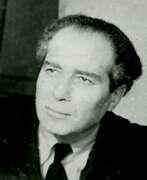

Joseph Alexandrovich Serebriany (Russian: Иосиф Александрович Серебряный) was a prominent figure in the Soviet art scene, known for his deep involvement in various artistic endeavors. Born in Horodnia, Chernigiv Province, in the Russian Empire in 1907, Serebriany showcased his talent and dedication to art from a young age. He pursued his education at several prestigious institutions, including the Poltava Studio of Art, the Leningrad College of Art and Industry, and VKhUTEIN / Institute of Proletarian Fine Arts, where he specialized in theatrical design.
Serebriany's contributions to art were vast and varied. During the challenging times of the Siege of Leningrad from 1941 to 1945, he worked as a poster designer, using his skills to bolster the spirits of those enduring the hardships of war. His commitment to education was equally noteworthy; he taught at the Ilya Repin Institute of Painting, Sculpture and Architecture for over three decades, shaping the minds of future artists. His works, characterized by realism and a focus on Soviet themes, earned him recognition as a People's Artist of the USSR in 1965, a testament to his significant impact on Soviet art.
Serebriany was also an active participant in the Leningrad Union of Artists, serving as its chairman during two periods, which highlights his leadership and influence within the artistic community. His artworks, which include a diverse range of paintings from portraits of Soviet heroes to scenes of significant historical events, are held in high esteem and form part of Russia's national art collection.
For art collectors and experts, Joseph Alexandrovich Serebriany's legacy is a fascinating exploration of Soviet-era artistry, reflecting the social and political atmosphere of his time. His contributions to art education and the portrayal of Soviet themes in his work offer rich insights into the era's artistic movements.
To stay updated on exhibitions and auctions featuring Joseph Alexandrovich Serebriany's work, signing up for updates is highly recommended. This subscription will ensure you are informed about new sales and events related to this influential artist, providing unique opportunities to engage with his impactful legacy.
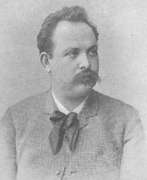

Nikolai Alexandrovich Sergeev (Russian: Николай Александрович Сергеев) was a Russian artist of the late 19th and early 20th centuries. He is known as a painter and graphic artist, academician of landscape painting.
Nikolai Sergeev created mainly landscapes, including with elements of genre scenes, with views of Ukraine. He was one of the founding members of the St. Petersburg Society of Artists and later of the Association of Artists.
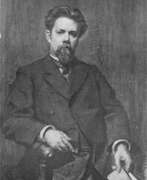

Nikolay Gustavovich Schilder (Russian: Николай Густавович Шильдер) was a Russian painter known for his genre and battle scenes. Born in 1828 in Kharkiv, Schilder became an influential figure in Russian art. He studied at the Imperial Academy of Arts and was influenced by the works of Pavel Fedotov, which led him to focus on genre painting.
Schilder's notable works include "The Temptation" (1857), "Family Happiness" (1858), and "The Repayment of Creditors" (1861), the latter earning him the title of academician. His detailed and emotive portrayal of everyday life and historical events made his works highly regarded in art circles.
Several of his paintings, including portraits of prominent figures such as Alexander III and Maria Feodorovna, are displayed in museums like the State Russian Museum and the Orsay Museum in Paris.
Stay updated on new sales and auction events related to Nikolay Gustavovich Schilder by signing up for our updates.


Ivan Nikolayevich Shulga (Russian: Иван Николаевич Шульга) was a Ukrainian Russian and Soviet artist of the first half of the twentieth century. He is known as a master of painting and drawing and a teacher. His name is included in the "Unified Art Rating of the world's 10,000 best artists" and in the list of the 100 most outstanding artists of Ukraine.
Ivan Shulga worked in different genres: he painted portraits, genre paintings, landscapes (marine, landscape, architectural, industrial), created still life paintings, panels, drawings for art postcards, political posters. His artistic legacy also includes pictures in the genre of nude and historical genre. The artist also illustrated magazines and books, designed theatrical sets.
Shulga worked in watercolor, pencil drawing, gouache, ink and sanguine, pastel, oil and tempera painting.
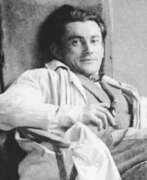

Marc Sigizmundovich Sterling (Russian: Марк Сигизмундович Стерлинг) was a multifaceted artist whose work spanned various genres and styles. His nationalities are diverse, reflecting affiliations with Germany, Russia, Ukraine, France, Switzerland, and the Russian Empire, showcasing a life lived across different cultures.
Marc Sterling's artistic endeavors included painting, engraving, and graphic art, with his talents extending to landscape and portrait painting. He was part of significant art movements and groups such as La Ruche, Salon d'Automne, and the School of Paris, indicating his active participation in dynamic artistic communities. His art, which embraced genres like flower still lifes, landscapes, and portraits, showcased a blend of Constructivism, Realism, and Synthetic Cubism, utilizing techniques ranging from engraving to oil painting.
For art collectors and experts, Marc Sterling's work offers a glimpse into the rich tapestry of 20th-century art, characterized by its diverse influences and innovative expressions. His contributions to the art world are reflected in his varied body of work, which continues to attract interest at art auctions and among collectors.
To delve deeper into the world of Marc Sigizmundovich Sterling and explore his creations, one can visit auction archives and collections that feature his work, providing insights into his artistic journey and the legacy he left behind in the realms of painting and graphic arts.


Yevgeny Ivanovich Stolitsa (Russian: Евгений Иванович Столица) was a Russian and Soviet artist of the late 19th century and the first third of the 20th century. He is known as a painter and graphic artist.
Yevgeny Stolitsa is best known as a landscape painter. He also painted portraits, historical and battle paintings. His works are distinguished by a fine transmission of the light and air environment, a free impressionistic style of painting, rich and saturated colors with lots of nuances and shades. According to critics, unpretentious rustic motifs in the artist's portrayal acquired a special poeticism.


Nikolai Nikolaevich Storozhevsky (Russian: Николай Николаевич Сторожевский) was a Russian, Ukrainian and Soviet artist of the first half of the twentieth century. He is best known as a landscape painter, representative of the Ukrainian avant-garde.
Nikolai Storozhevsky was one of the founders of the Association of Kharkov artists. After the disintegration of this group he participated in the creation of the creative association "Union of Arts".
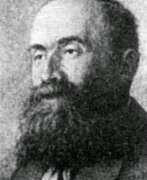

Sergey Ivanovich Svetoslavsky (Russian: Сергей Иванович Светославский) was a Russian Ukrainian and Soviet artist of the late 19th - first third of the 20th centuries. He is known as a painter-landscaper and graphic-caricaturist.
Sergey Svetoslavsky in his works created a lyric-epic image of Ukraine. Most of all he was attracted by the urban landscapes of Kiev and rural landscapes around the city. One of his favorite subjects were views of the Dnieper. The master was a member of the Association of Traveling Art Exhibitions and his city landscapes were done mainly in gray-brown tones, which was typical for the Itinerants.
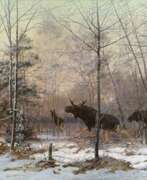

Evgeny Alexandrovich Tikhmenev (Russian: Евгений Александрович Тихменев) was a Russian artist, born in 1869 and passed away in 1934. Renowned for his depictions of natural scenes and hunting expeditions, his works encapsulate the essence of rural Russian life during his time. Tikhmenev's artwork, such as "Before the Hunt," captures moments of anticipation and interaction with nature, often featuring meticulous detail and vibrant settings.
His pieces are cherished in art circles for their historical value and their ability to convey the story of an era when hunting was not only a sport but a significant aspect of rural survival and culture. Notably, Tikhmenev's paintings have been sold at various auctions, with some pieces fetching substantial prices, highlighting their desirability among collectors and art enthusiasts.
For collectors and experts in art and antiques, Tikhmenev's works present a valuable investment, both culturally and financially. To stay updated on new sales and auction events featuring Evgeny Alexandrovich Tikhmenev’s work, signing up for timely updates is recommended, ensuring enthusiasts don't miss out on acquiring a piece of Russian art history.
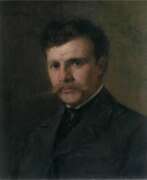

Mikhail Stepanovich Tkachenko (Russian: Михаил Степанович Ткаченко) was a late 19th- and early 20th-century Russian artist of Ukrainian descent. He is known as a painter and graphic artist who lived most of his career in France.
Mikhail Tkachenko worked as a landscape painter, marinist, and painted scenes of naval battles. For some time he was the first painter of the Main Naval Staff of the Russian Empire. Most of his works are in state collections in France, some are kept in the Central Naval Museum in St. Petersburg.
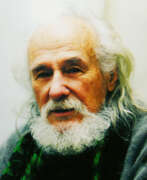

Victor Ivanovich Tolochko (Russian: Виктор Иванович Толочко) was a Soviet and Ukrainian artist of the second half of the twentieth and early twenty-first centuries. He is known as a painter, a decorated participant of the Great Patriotic War, a master of landscape, still life, battle and historical genres.
When working in the historical genre Victor Tolochko tried to live in the historical atmosphere. Working on the painting "Defenders of the Brest Fortress", he lived in the fortress for six months and created more than 50 sketches and sketches. In addition to the military theme, the master's life-affirming landscapes were also highly appreciated by critics.
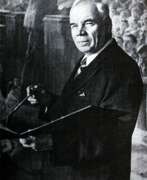

Karp Demyanovich Trokhimenko (Russian: Карп Демьянович Трохименко) was a Soviet Ukrainian painter known for his significant contributions to socialist realism. Born in 1885, Trokhimenko's works primarily depicted scenes of everyday life, socialist construction, and the natural beauty of Ukraine.
Trokhimenko's distinctive style is characterized by his detailed, realistic portrayal of his subjects, capturing the spirit and ideals of the Soviet era. He was celebrated for his ability to convey the human experience within the broader context of socialist society. His paintings often featured vibrant colors and meticulous attention to detail, making them stand out in exhibitions.
Among his notable works are "Shevchenko and Engelhardt" (1939), "Kateryna" (1959), and "May Days in Old Kyiv" (1975), all housed in the National Art Museum of Ukraine. These paintings exemplify his talent in depicting historical and rural life with a sense of warmth and authenticity. Trokhimenko's legacy continues to influence contemporary Ukrainian artists, and his works remain highly regarded in art circles.
For updates on new product sales and auction events related to Karp Demyanovich Trokhimenko, sign up for our newsletter.


Valentina Petrovna Tsvetkova (Russian: Валентина Петровна Цветкова) was a Soviet and Ukrainian artist of the second half of the twentieth and early twenty-first centuries. She is known as a painter and graphic artist, a master of landscape, still life and portraiture, who mastered various painting and drawing techniques, including oil, pastel, watercolor, acrylic, pencil and felt-tip pen.
Valentina Tsvetkova in her work focused on the diversity of forms of nature, unique features of climate, flora, architecture and the way of life of people. Her landscapes were characterized by originality and decorativeness, and portraits reflected the main features of appearance and inner essence of each depicted person. The artist painted portraits of war heroes, as well as scientists and representatives of the creative intelligentsia.


Serhii Ivanovych Vasylkivsky (Russian: Сергей Иванович Васильковский) was a distinguished Ukrainian artist, celebrated for his profound contributions to the realms of painting and art education. Born in 1854 in Kharkiv, Vasylkivsky's works are a testament to his deep connection with the Ukrainian landscape, culture, and history. His paintings, characterized by their vivid depiction of natural scenes and historical narratives, have earned him a place among the most revered figures in Ukrainian art history.
Vasylkivsky's artistic journey was marked by his exceptional ability to capture the essence of the Ukrainian soul through his landscapes and scenes of daily life. His works not only reflect the beauty of Ukraine's natural landscapes but also embody the spirit of its people, their traditions, and their struggles. Vasylkivsky was a master in utilizing light and color, creating paintings that are alive with emotion and atmosphere. His contributions to art were not limited to his own creations; he was also a dedicated educator, imparting his knowledge and passion for art to future generations.
Among Vasylkivsky's most notable works are his landscapes and historical paintings, many of which are housed in prestigious museums and galleries across Ukraine and beyond. His ability to blend realism with a sense of romanticism has left a lasting impact on the art world, making his works highly sought after by collectors and experts in art and antiques. Vasylkivsky's legacy is not only preserved in his paintings but also in his influence on the development of Ukrainian art.
For collectors and aficionados of fine art, the works of Serhii Vasylkivsky offer a unique window into the soul of Ukraine. We invite you to sign up for updates on new product sales and auction events related to Vasylkivsky's art. This subscription is your gateway to owning a piece of Ukrainian cultural heritage, celebrated for its beauty, depth, and historical significance.
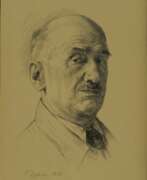

Georgy Semyonovich Vereisky (Russian: Георгий Семёнович Верейский) was a Russian and Soviet artist of the first half of the twentieth century. He is known as a painter, graphic artist, and representative of the Leningrad school of landscape painting.
Georgy Vereisky specialized in graphic portraits and landscapes, using lithography, etching and drawing. His works were characterized by accuracy in conveying the characters of models and clarity of lines. The master created many landscapes and genre compositions. He is particularly known for his series of lithographs, including portraits of Russian artists, and works dedicated to Soviet figures, pilots, workers and cultural figures.
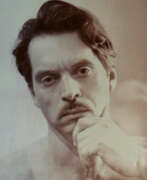

Yuri Vasilievich Volkov (Russian: Юрий Васильевич Волков) was a Soviet artist of the second half of the twentieth century. He is known as a battle painter.
During the Great Patriotic War Yuri Volkov defended Sevastopol, was captured and wounded, liberated the capitals of Europe from the Nazis. In the postwar years he created a series of battle works about the heroism of Soviet soldiers and the tragedy of the German occupation. Volkov's work is also represented by genre paintings about the labor and leisure of Soviet citizens. The artist, being an Orthodox Christian, also painted churches. His works are known for their realism and dynamic composition, which vividly convey the heroism and tragedy of war.


Vasily Alekseyevich Volkov (Russian: Василий Алексеевич Волков) was a Russian and Ukrainian artist of the last third of the 19th - early 20th centuries. He is known as a painter, watercolorist and teacher.
Vasily Volkov painted portraits and paintings on domestic and historical themes. Especially famous are his portraits of Emperors Alexander II and Alexander III, as well as historical portraits.
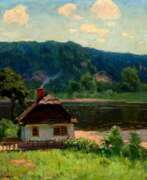

Konstanty Wroblewski (Russian: Константин Харитонович Вроблевский) was a Polish artist known for his evocative landscapes and detailed genre scenes. Born in 1868 and active until his death in 1939, Wroblewski's work primarily focused on capturing the serene beauty of rural Poland. He was recognized for his ability to depict natural lighting with remarkable precision, often highlighting the tranquil yet vibrant countryside.
Wroblewski's paintings have been featured in various notable collections and have fetched significant prices at auctions. Two of his well-known works, "The Edge of the Village at Sunset" and "Cottage," exemplify his talent for portraying the Polish landscape with a delicate balance of color and light. These pieces have been auctioned multiple times, with "The Edge of the Village at Sunset" selling for PLN 8,500 and "Cottage" for PLN 7,000, reflecting their enduring appeal to collectors.
For those interested in acquiring works by Konstanty Wroblewski or staying updated on future auctions, consider signing up for notifications. This will ensure you receive alerts about new product sales and auction events related to this esteemed artist.
Stay informed about Konstanty Wroblewski's works by subscribing to our updates today.
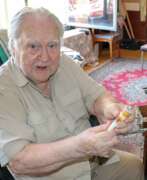

Vitaly Georgievich Yablonovsky-Snadzsky (Russian: Виталий Георгиевич Яблоновский-Снадзский) is a Soviet and contemporary Russian artist. He is known as a painter specializing in landscapes and still lifes.
Vitaly Yablonovsky-Snadzsky is also known for his monumental paintings of sanatoriums in Sochi, where he lives permanently. He has been actively creating since the early 1970s. Among his most famous works are the paintings "Gifts of Autumn", "Red Poppies", "Dry Grasses", "Clusters of Rowanberries", "Crayfish" and others.
His works are in museums and private collections in Russia and other countries - in Germany, Poland, Yugoslavia, Finland, Syria, France, Spain, USA, Turkey.


Stepan Petrovich Yaremich (Russian: Степан Петрович Яремич) was a multifaceted Ukrainian artist and art historian, whose career spanned the late 19th and early 20th centuries. His profound contributions to art history and preservation, particularly during the tumultuous post-revolutionary period in Russia, underscore his significance beyond his work as a painter. Yaremich's expertise in Western European drawing, bolstered by his years in Paris where he amassed an impressive collection featuring masters like Watteau and Fragonard, highlighted his remarkable connoisseurship.
Educated in Kiev and Paris, Yaremich was associated with the "World of Art" movement and worked closely with figures like Alexandre Benois. He was not just an artist but a respected art expert, often involved in the restoration and cataloging of Russian and Western European art. His time at the Hermitage and Russian Museum showcased his dedication to art preservation, contributing significantly to the fields of art history and conservation.
Yaremich's artistic legacy includes landscapes of St. Petersburg, Venice, and other locales, characterized by a unique approach to color and form that distinguished his work from his contemporaries. Despite the critical acclaim, it was his behind-the-scenes work as an art historian and conservator that solidified his enduring impact on the art world.
Collectors and experts in art and antiques will find Yaremich's work both compelling and significant, underlining the importance of not only creating art but also preserving it for future generations. For updates related to Stepan Petrovich Yaremich, including sales and auction events, sign up for our newsletter. This subscription will keep you informed about the latest findings and opportunities to acquire works associated with this remarkable figure in art history.


Nikolai Alexandrovich Yaroshenko (Russian: Николай Александрович Ярошенко) was a prominent Russian painter of Ukrainian origin, recognized for his profound contributions to genre and portrait painting, particularly focusing on societal themes and the daily struggles of working people. Born on December 13, 1846, in Poltava, then part of the Russian Empire, Yaroshenko initially pursued a military career before devoting himself to art.
Yaroshenko became an influential member of the Peredvizhniki, a group of Russian realist artists who sought to portray real life with a moral or social message. His works are notable for their depth of emotion and social commentary, highlighting the lives of the common folk and the societal challenges of the time. Among his well-known paintings are "The Stoker" and "The Prisoner," both of which reflect his concern for the plight of the oppressed and showcase his skill in evoking empathy through art.
Many of Yaroshenko's masterpieces are housed in prominent Russian museums, such as the Tretyakov Gallery, reinforcing his status in the annals of art history. His works continue to resonate, providing insight into the social dynamics of 19th-century Russia and the struggles therein.
For art collectors and experts interested in the poignant realism and historical depth of Yaroshenko's paintings, staying updated on exhibitions and auctions featuring his work can be incredibly rewarding. To receive alerts about new sales and auction events related to Nikolai Alexandrovich Yaroshenko, consider signing up for updates through specialized art platforms.
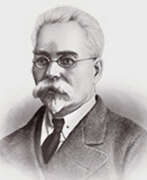

Viktor Ivanovich Zarubin was a distinguished painter and scenographer, remembered for his contributions to both Ukrainian and Russian art. Born on November 13, 1866, in Kharkiv, which at the time was part of the Russian Empire, Zarubin's career spanned the late 19th and early 20th centuries. His diverse heritage is reflected in his works, which often depict landscapes imbued with human figures, capturing the essence of the regions he represented.
Zarubin's artistic prowess was not limited to painting; he was also a skilled graphic artist and watercolorist. His ability to blend the serene beauty of landscapes with the nuanced portrayal of figures earned him recognition in the art world. His works have been featured in various galleries, highlighting his significance in the artistic community and making him a subject of interest among collectors and auctioneers.
